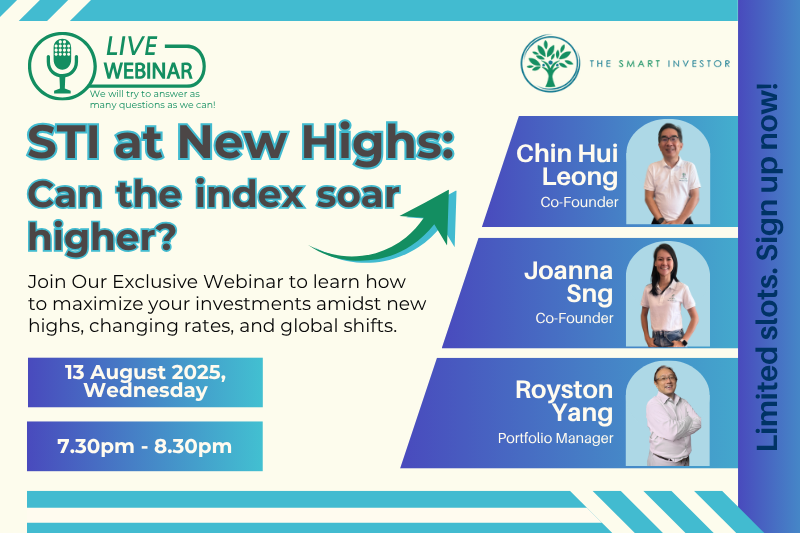REITs are among the most popular investments in Singapore.
They promise steady payouts and attractive yields, especially when interest rates are low.
But many investors fall into the same trap when buying them.
The #1 mistake? Chasing yield blindly, without understanding the risks behind it.
The Allure of High Yields
In Singapore, the average dividend yield of Singapore REITs (S-REITs) and property trusts was 6.2% as at 30 September 2025.
That’s higher than bank deposits or government bonds, which is why REITs are still a natural home for income-seeking investors.
Then you have the eye-catchers.
On the surface, yields like these look irresistible.
In practice, they might be too good to be true.
For example, EC World REIT (SGX: BWCU) reported an annualised distribution yield of about 13.1% for 2022 and 10.7% for 2023, even as refinancing issues piled up and its long-term future grew murkier.
Prime US REIT (SGX: OXMU) is another case.
The REIT’s 2022 first half (1H2022) results highlighted an annualised distribution yield of 10.5% based on the closing unit price as at 30 June 2022.
A year later, annualised distribution yield was 23.6%, with management slashing the cash payout for 2H2023 by more than 90% to keep most of the cash in the REIT instead of paying out.
That’s the real lesson: when a yield stretches far above the pack, it’s rarely a free upgrade.
It’s a signal to dig deeper and ask questions.
The #1 Mistake: Chasing Yield Blindly
High yields don’t always mean high quality. Too often they come from:
- Falling unit prices (which make yields look better on paper);
- Unsustainable payout ratios, where REITs distribute more than they earn; or
- Weak fundamentals like high gearing, poor occupancy, or rising interest costs.
For instance, in the second quarter of 2025, 20 of 38 S-REITs were yielding above 7%, even as the average gearing ratio was at 40%.
Two REITs show how this can turn into a classic yield trap.
Lippo Malls Indonesia Retail Trust (SGX: D5IU)
In FY2016, Lippo Malls Indonesia Retail Trust reported a total DPU of S$0.0341, which worked out to an annualised yield of 9.2%, making that payout look generous.
Over time, though, the picture changed.
Distributions per unit (DPU) shrank sharply, and by 2023 the trust had reduced its quarterly payout to hardly anything, before withholding distributions altogether while it grappled with high interest rates, FX pressures and refinancing needs.
Investors who bought in purely for the high yield ended up facing shrinking income and, eventually, no distribution at all.
Manulife US REIT (SGX: BTOU)
For 1H2021, the REIT reported a DPU of US$0.027, an attractive income play for a US office portfolio, at least on paper.
Then, reality hit, and the US office market weakened, property valuations tumbled, and gearing climbed dangerously high.
By 1H2023, the REIT halted distributions due to its deteriorating debt situation.
In 2024, distributions were suspended entirely through end-2025 as part of desperate negotiations with lenders.
Here’s the cruel irony: as the unit price collapsed, the backward-looking yield metrics actually looked more and more attractive. Right up until distributions stopped completely.
What Investors Should Look At Instead
If you want to avoid yield traps, focus on what really keeps the payouts flowing.
1. Balance-Sheet Strength
Look at gearing, interest coverage, how much debt is fixed vs floating, and when the loans are due.
A REIT that’s sitting on short-term, floating-rate debt is much more exposed when rates stay high or credit tightens.
Take Parkway Life REIT (SGX: C2PU) for example.
- In 3Q2025, the REIT’s gearing was in the mid-30% range.
- With the exception of 2027, the REIT does not have to refinance more than 16% of its debt in any single year.
That’s the kind of profile that supports distributions: moderate gearing, debt spread out, and most of the interest cost already locked in.
2. Portfolio Quality
Next, look at the actual properties and tenants.
Key things to look at include:
- Occupancy (how much of the space is actually leased)
- Tenant mix and concentration
- Lease expiry profile (WALE) and the strength of the locations
CapitaLand Integrated Commercial Trust (SGX: C38U) provides a good illustration.
The REIT maintained committed occupancy of 98.7% for its retail portfolio and 96.2% for its office portfolio as at September 2025, proving that prime malls and Grade A offices can stay almost fully occupied even through cycles.
This high, sustained occupancy in well-located properties tells you the underlying assets are pulling their weight, so the yield is backed by real tenant demand, not financial engineering.
3. Distribution Track Record
Finally, look out for payout trends.
One year of “fat” yield doesn’t say much.
A long series of stable or rising DPUs, through different interest-rate and economic environments, is a much better indicator of quality.
For example, Mapletree Logistics Trust (SGX: M44U) has steadily nudged its quarterly DPU higher over the years:
- In 2QFY2012/2013, it reported a DPU of S$0.0171.
- Today, its 2QFY25/26 distribution was at S$0.0185 per unit for the quarter ended 30 September 2025.
The increase isn’t explosive, but that’s the point: slow, consistent growth in DPU, supported by a larger and better-quality logistics portfolio, is far more reassuring than a sudden spike in yield.
What This Means for Investors
Yield is only the headline; sustainability is the real story.
Smart investors don’t just scan for the highest number.
They ask: Is this payout backed by stable cash flow? Can the REIT handle rising rates?
Get Smart: Don’t Let Yield Blind You
The biggest mistake REIT investors can make is chasing the percentage and ignoring the picture.
Dividends are only as strong as the business behind them.
If you want lasting income, build on quality, sustainability, and balance-sheet strength, not just the number that shouts the loudest.
What are the stock secrets to Singapore’s “quiet millionaires?” Chances are, you’ll find at least one of their favourites in this free report. Download it now and see how these stocks could power your portfolio!
Follow us on Facebook, Instagram and Telegram for the latest investing news and analyses!
Disclosure: Alex does not own any of the shares mentioned.





